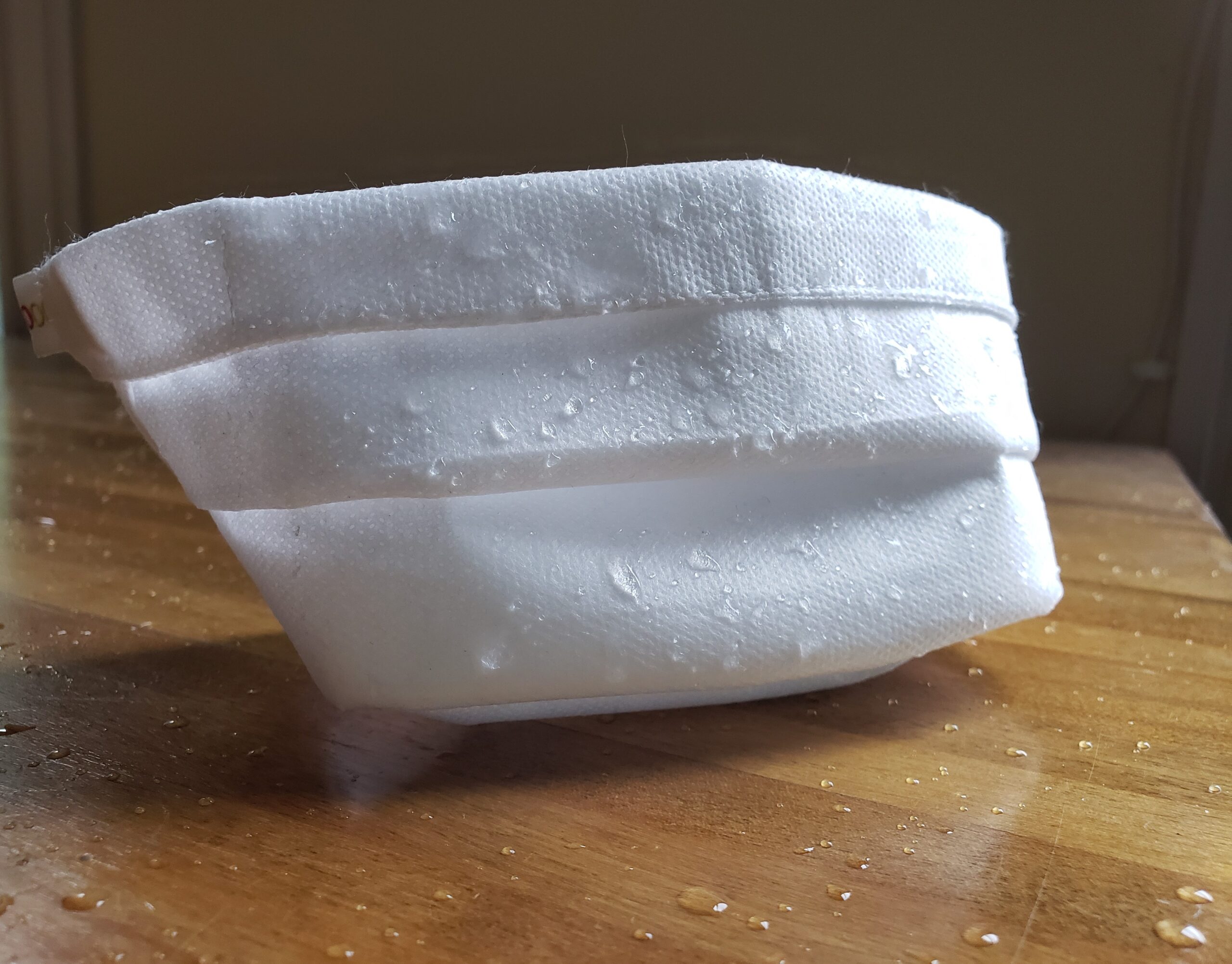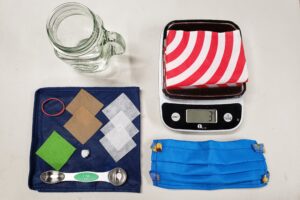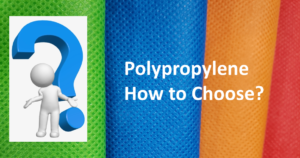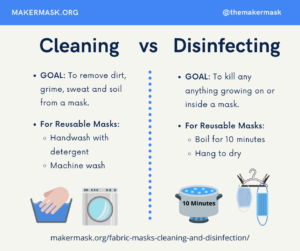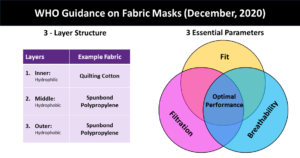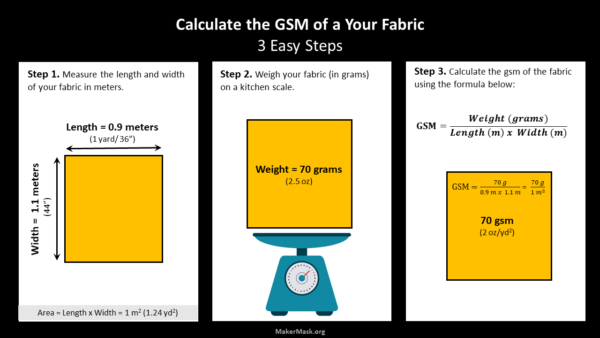In this FAQ we answer questions about reusable fabric masks (nonmedical masks), including questions about mask fabrics, nonwoven polypropylene (NWPP), and mask designs. Some of the key questions answered in this FAQ are:
Questions About Polypropylene
What is polypropylene?
Polypropylene (PP) is a lightweight synthetic material that is inexpensive, durable, breathable, water resistant, and recyclable (#5). PP is generally considered non-toxic, and safe for human contact. PP is used in a broad range of applications and is available in many forms. For example, PP is available as sheets of plastic (e.g., in yogurt containers), as woven fabrics (e.g., in clothing), and as nonwoven fabrics (e.g., in masks). The type of polypropylene used in masks in nonwoven polypropylene (NWPP).
Is polypropylene safe?
Yes, polypropylene is nontoxic and is generally considered the safest plastic for human use. However, as with all textiles, there are different thicknesses and grades of NWPP and we cannot guarantee or vouch for the effectiveness of hand-made masks constructed from alternatively sourced materials. For more information to help guide your selection of polypropylene materials for community masks read more at: “The Big 4: Criteria for Community Mask Materials.”
Why is nonwoven polypropylene used in masks?
Nonwoven polypropylene is used in masks because it is nontoxic, breathable, hydrophobic (water-resistant), lightweight, provides filtration, and is inexpensive.
- For more on the criteria for community sourced mask materials see: “The Big Four: Criteria for Fabric Mask Materials for COVID“
- Fore more on how to do DIY testing of mask fabrics & layers see: “3 Easy DIY Mask Tests”
- For more on the importance of water resistance of NWPP see: “Fluid Resistance: Mask Material Test Results“
- For more on the filtration performance of NWPP in masks see: “Research Highlights: NWPP Filtration Efficiency from Long et al 2020″
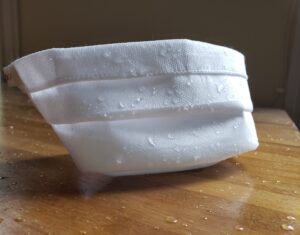
What is nonwoven polypropylene?
Nonwoven polypropylene (NWPP) is the most common material used in medical grade masks. Instead of being woven like cloth, NWPP is created by spinning polypropylene fibers into threads and laying them down in a porous web that is breathable, provides filtration, and is naturally water resistant. There are two different types of NWPP that are used in masks: spunbond NWPP and meltblown NWPP.
What is the difference between spunbond and meltblown NWPP?
Spunbond NWPP is washable and reusable where meltblown NWPP is considered a single-use (disposable) material. This is because of structural differences in the materials and how they are manufactured. For reusable fabric masks we recommend spunbond NWPP. For a deeper dive into the differences between spunbond and meltblown NWPP, see: “Mask Fabrics: Introduction to Fibers and Fabrics”
- Spunbond NWPP is a sturdier material spun from larger diameter fibers that are thermally bonded together, which makes them more suitable for washing and reuse.
- Meltblown NWPP is constructed from smaller, more delicate fibers, resulting in a material that is not generally considered washable or reusable. Although meltblown NWPP is considered safe in commercially manufactured masks and filter inserts, the size of meltblown fibers suggests extra caution may be warranted when cutting, handling, and/or sewing these materials due to potential inhalation risks.
Is spunbond polypropylene good for reusable face masks?
Yes. Spunbond NWPP is considered a good choice for fabric masks because it is lightweight, reusable, breathable, water-resistant, and helps with filtration. However, meltblown NWPP is not considered washable and should not be sewn into reusable masks. For more on how to identify and select NWPP for masks see: “The Big Four: Criteria for Fabric Mask Materials for COVID“
Where can nonwoven polypropylene be purchased?
Spunbond nonwoven polypropylene can be upcycled from a number of different places, and can be found in bulk (i.e., by the yard) as sewing and/or crafting material. Specifics about where to buy NWPP vary regionally. Click here for our guide to “Finding and Selecting Polypropylene for Washable Masks“
Questions About Reuse, Cleaning, and Disinfection
Are nonwoven polypropylene masks reusable?
Yes, fabric masks made from spunbond nonwoven polypropylene can be washed and reused (by the same individual). Disposable medical masks (and respirators) that contain meltblown NWPP are designed to be safely discarded after a single use, but due to ongoing shortages may be reused up to five times when safely stored (e.g., in a breathable paper bag) for at least 5 days between uses [CDC, 2020].
- For more information about reusing fabric masks, see “Fabric Face Masks: Cleaning and Disinfection”
- For more information about safely reusing medical masks, see: The CDC’s Guidance Respirator Reuse.
Can nonwoven polypropylene be washed?
Yes, spunbond NWPP can be washed. Check for specific washing instructions from the mask and or material manufacturer. In general:
- NWPP can be hand washed in warm or hot water, rinsed thoroughly, and hung to dry. Handwashing may extend the longevity of NWPP materials.
- NWPP can be machine washed (warm) and tumble dried (low). We recommend putting NWPP masks in lingerie bags while washing to help them retain their shape.
Avoid using bleach or alcohol on these fabrics, because those chemicals break down the properties that make NWPP a good choice. Be sure to rinse masks thoroughly to eliminate soap residues, which may alter mask properties. Do not use fabric softener as it leaves residues that may alter the properties of the fabric.
For disinfection, spunbond NWPP masks may be boiled for 10 minutes and then hung to dry.
- Click here for more information about “Fabric Face Masks: Cleaning and Disinfection”.
Is nonwoven polypropylene recyclable?
Yes. NWPP is recyclable (look for recycling #5). Check with local and regional recycling policies for details. In addition, the spunbond NWPP used in fabric masks can be washed and reused, which helps cut down on waste.

Questions About Mask Layering and Construction
How many layers should my mask include?
Best practices currently suggest that fabric masks should be constructed of three or more layers of breathable fabrics [WHO, 2020]. For more information about the WHO Guidance on Fabric Masks (last updated December, 2020) check out: “WHO Fabric Mask Guidance – December Updates“
What fabrics and layers should be used for each layer?
In general, the materials considered best for use in reusable fabric masks are water-resistant nonwoven fabrics (e.g., NWPP) and tightly woven cotton fabrics. For general use, MakerMask typically recommends either 3 layers of NWPP (NWPP-NWPP-NWPP), or a skin-contacting layer a hydrophilic fabric (e.g., cotton) with 2 outermost layers of NWPP (cotton-NWPP-NWPP). The NWPP layers are designed to act as barriers to droplets, which help contain the users droplets and help protect the user by preventing outside droplets from penetrating the mask [Songer, 2020]. For more information see,
Can I use cotton as the outermost mask layer?
We recommend using NWPP as the outermost mask layer due to its water resistance and hydrophobic properties. If a cotton layer is included, using it as the innermost mask layer (closest to the skin) to absorb the users droplets is preferred [WHO, 2020]. For more information, see:
- “WHO Fabric Mask Guidance – December Updates“
- “Adopting WHO Guidance on Fabric Masks for COVID-19 (July 2020)”
Should I iron NWPP masks? What about while I’m making the folds?
NWPP has been known to melt with some irons and could damage both the mask and your iron. For this reason, we do not recommend ironing. If you do decide to iron your masks, use precautions for sensitive/delicate fabrics such as ironing on the lowest heat setting and placing a towel or other cloth between the mask and your iron.
What is GSM and how is it calculated?
Both woven and nonwoven fabrics can be characterized by ‘fabric weight’ in terms of grams per square meter (gsm) o ounces per square yard (oz/yd²). Although we use gsm throughout our discussions, depending on where you are, oz/yd² may be used. It is easy to convert from one to the other by googling it, or using an online conversion tool such as this “Textile and Fabric Weight Converter”.
We use gsm to describe fabrics because it can be used to describe both woven and nonwoven fabrics and it can be easily measured by scientists and home sewists alike. All you need is a kitchen scale and a ruler!
How can I measure the GSM of my fabrics (cotton and NWPP) at home?
If the gsm (grams per square meter) of a given fabric is not provided by the manufacturer, it can be calculated at home using a digital kitchen scale, a ruler, and either a calculator following these three easy steps:
- Measure the length and width of your fabric in meters (or convert to meters; e.g., 1 cm = 0.01 m, 1 inch = 0.025 m, or 1 yard = 0.9 m).
- Weigh your fabric on a kitchen scale in grams (or convert to grams; e.g., 1 ounce = 28 grams).
- Calculate the gsm of the fabric using the formula below:
GSM = Fabric Weight / (Length x Width)


